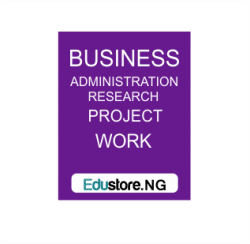Chapter One Introduction
-
Background of the Study
Management is on the verge of a major breakthrough in understanding how industrial company and public organization success depends on the interactions between the flows of information, materials, money, manpower, and capital equipment (Forrester 1958).
Supply chain management is complicated, because it takes 80% of their turnover comprising bought in goods and services (CIPS, 2013). Procurement is one of the components of supply chain which has the major impact for success or failure of public and private organizations. Public institutions as well as state-owned enterprises need to procure goods, services and works to carry out their responsibilities and duties. The total volume of public procurement, which is the government activity of purchasing goods, services and works accounted which in all countries in the world. The financial activities of government procurement are believed to be in the order of 10% – 30 % of GNP (Callender G and Mathews D, 2000). On the other hand; purchases of outside goods and services has always played an important role in the corporate cost structure reaching as high as 80% or more of the total cost of goods sold in some industries (Matthew G. Anderson and Paul B.Katz, 1998).
Public procurement has become a very complex function of government that covers a great proportion of public expenditures (which reach 70% of total government expenditure, according to numerous World Bank reports) and procurement expenditures (or “spends,” a term found in numerous reports and publications). It is estimated that 15% of the world‟s Gross Domestic Product (GDP) is spent through public procurement (Development Assistance Committee, 2005). It is further estimated that public procurement accounts for 9%–13% of the GDP of the economies of developing countries. In Angola, public procurement accounts for 58%, in Malawi it accounts for 40%, in Uganda it accounts for 70% of public spending (Thai, 2001). Expenditure on public procurement in Nigeria takes the lion share from the annual government budget. It took 64% of the annual budget or 15% of the GDP (PPD Report, 2014). Generally; procurement is the main driver in both public and private organizations.
Currently, most of the procurement process in public and private organizations is executed by bid/tender based system. Even if one of the main objectives of procurement is to reduce cost through competition, promoting transparency, safeguarding public and private funds, as well as reducing and eliminating corruption, the bid/tender system has many drawbacks to fulfill the needs of organizations.
The public and private organizations have common value for money but they are apart in procuring goods and services by long term supplier relationship which is important for procuring quality goods and services, less delivery time and minimum cost without ignoring transparency and accountability.
But in the present day, every business needs to establish strong, mutually beneficial relationships with strategically chosen partners. The longer that relationship lasts, the better for all parties. The advantages include improved performance, greater cost efficiency and helping businesses to develop. The ultimate goal of public procurement and business firms purchasing system is to spend the money in an efficient and proper manner to achieve best value for money.
1.2 Statement of the Problem
The principle of competitive bid/tender based procurement system is advised in order to procure goods and services that give value for money, but on the ground, it is not truly practiced. It is expressed as adversarial practice. According to the expressions of (Shapiro, 1986; Amihud, 1976; Marquardt; 1988) quoted by (Joseph P. Cannon Christian Homburg, 1988) adversarial approaches involve bidding rituals that pit multiple suppliers against one another in an effort to drive down prices. The traditional adversarial relationship is characterized by a price focus, and short-term contracts. This adversarial relationship is mainly focused only on cost breakdown.
Due to the lack of long term partnership between the buyer and the supplier most public and private organizations are obliged to use the competitive bidding system to buy the material. It tends to focus on the short term view of the purchase price and profit of a product instead of long-term capabilities of the suppliers. This competitive bidding purchasing or procuring material and service may affect the customer or the buyer organizations. The risk of buying
wrong items, services and products from wrong suppliers reduces the market share, long-term profitability and competitiveness of the company.
Public organizations also procure goods and services for improvement public infrastructure and for the development of the country. But the consequences of poor procurement practices result in loss of the public money by delaying mega and small projects, it affects the health organizations and different government projects in cost, quality and delivery time. This competitive bidding system does not allow the buyer to use small number of supplier base, increase the uncertainty in quality cost and delivery time. This process is obliging the buyer for another re-tendering and re- negotiation. Due to this the total ownership cost increases and it affects the performance of the organizations.
The current supplier-buyer relationship practice in most public and private organizations in Nigeria is based on transactional basis instead of strategic alliances. The most accustomed and taken as transparent way of procurement is bid to purchase. Though this may enable to secure least price bid, it may not guarantee sustained lower cost, quality, short delivery time, share appropriate feedbacks and improved reliability and poor approach for innovation. Although public procurement is perceived as a major function of government, and although governmental entities, policy makers and public procurement professionals have paid a great deal of attention to procurement improvements or reforms, public procurement has been a neglected area of academic education and research (Thai, K.V, 2001).
Many scholars have written about supplier- buyer relationship in different organizations. (Carolyne Tangus C, Luke A. Oyugi and Charles Rambo, 2015; Maram Roushdy et al, 2015: Rachel Duffy and Andrew Fearne, 2004; Mutie Brian Musanga, 2015). They tried to explain the important effects of supplier relationship management. Especially they have tried to emphasise on business organization like manufacturing sector. But they did not explain how to build long term relationship between supplier and buyer in business and public organization as common agenda.
Due to this, the thesis deals with new way of long term relationship formation for procuring goods and services in public and private organizations. The research is mainly focused on the analysis of problems which are created during procuring goods and services by bid/tender based
system and the formation of long term supplier relationship management in public and private organizations by using qualitative system dynamics model.
1.3 Research Objectives
It is difficult in this dynamic, technology intensive and short product cycle environment to increase the performance of public organizations and competitiveness of private sector on procurement of goods and services by bid/tender based system. The existing tender/bid system procurement method has some problem related to quality, delivery time and cost. So, it needs to look forward for better way of addressing the issue; accordingly, this study has focused to deal with the following general and specific objectives;
1.3.1 General Objective
The general objective of the research is to investigate the gaps in the existing bid/tender based procurement system and develop a model for long term supplier relationship management between buyer and supplier that increases quality, minimize delivery time and optimum cost when procuring goods and services.
1.3.2 Specific Objectives
- To investigate the problems that occur during procuring goods and services based on bid/tender
- To determine the variables that are important for long term supplier relationship for increasing the quality, reducing delivery time and cost and thereby increase the performance of
- To develop a model through qualitative system dynamics that helps to procure goods and services for public as well as private organizations as a better alternative
1.4 Research Questions
- What are the procurement process problems that occur in the bid/tender based system in Nigeria?
- How does one determine the variables that are important for long term supplier relationship to increase quality, minimize delivery time and cost, increase organizations performance?
- What kind of model is recommended to be developed using system dynamics for long term supplier relationship?
1.5 Output and Significance of the Study
Ineffective procuring goods and services by competitive bid/tender system indicated that there is a need to change into well designed and effective long term supplier relationship management system. This long term supplier relationship management system is more effective for quality, cost and delivery time minimization along with transparency and accountability both in public and private organizations compared to the tender system.
In this research, long term supplier relationship model is developed by system dynamics qualitative model. It also identifies the areas where the problems of bid/tender system in public and private organizations. It is also useful as an additional material for public and private organizations for increasing performance and market competitiveness for giving value for money through building long term partnership.
The output of this study contributes to the literature gap on the problems of bid procurement method. In addition it contributes to build long term supplier relationship that increases the overall organizational performance.
In this study, the problem of bid/tender based procurement system is analyzed by system dynamics of causal loop diagram. The need of paradigm shift from competitive bid/tender system to long term partnership system is highly elaborated. Emphasis is given to the importance and system of implementing the long term supplier relationship in public and private organizations. Therefore, it will help a number of organizations including: research and development organizations, traders, producers, policy makers, extension service providers, governmental and non-governmental organizations to assess their activities and redesign their mode of operations and ultimately influence the design and implementation of policies and strategies. It could also help different actors to identify and analyze new ways of stimulating innovation.
DOWNLOAD COMPLETE WORK- For Reference Only: Materials are for research, citation, and idea generation purposes and not for submission as your original final year project work.
- Avoid Plagiarism: Do not copy or submit this content as your own project. Doing so may result in academic consequences.
- Use as a Framework: This complete project research material should guide the development of your own final year project work.
- Academic Access: This platform is designed to reduce the stress of visiting school libraries by providing easy access to research materials.
- Institutional Support: Tertiary institutions encourage the review of previous academic works such as journals and theses.
- Open Education: The site is maintained through paid subscriptions to continue offering open access educational resources.






